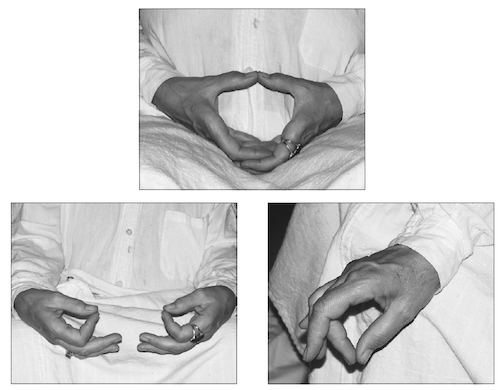MUDRAS AND MOVING MUDRAS
This is small yet useful way to help maintain focus of your attention while you meditate. It can help you keep your mind from rambling around when that’s not what you want to do. It’s an alternative to the “visual splitting” described in another blog. Actually this is simpler and more basic.
A mudra is a hand position of a kind used by both Budhist and Hindu meditators. The position of palms together and fingers pointing upward used in Christian prayers and also those of many other spiritual traditions is a mudra. Its meaning is a communication with the divine (which might or might not actually happen, depending on your state of consciousness.) This prayer mudra is called the atmanjali. In some cultures it’s also used as a sign of respect or gratitude —especially Japan and India.
Another popular mudra is the jnana mudra that symbolizes opening the heart to the wisdom of heaven. You’ve probably seen a statue of the Buddha sitting cross-legged with his palms turned skyward on his legs and the thumb and index finger of each hand touching. Or you can use the thumb and middle finger.
If you’re in public and you want to meditate without looking obvious you can turn the jnana mudra upside down as shown in the third of the three pictures with this blog. Long ago I started sometimes doing that after I was using the jnana mudra while sitting against a pillar meditating as I waited for a train in a crowded railway station waiting room in which all the seats were gone. I didn’t want to move until my meditation was finished.Some people thought I was begging and dropped coins into my hand. After that I started turning the jnana mudra upside down in public. I call that the invisible mudra. All others can see is your knuckles.
There are many mudras. You can find entire books about them. These three are enough for me.
Maintaining a mudra can help keep a clear centered mental state. In the Zen tradition if your thumbs droops instead of keeping your mudra almost circular it’s a sure sign that your mind has wandered.
For me with my typically busy mind a mudra wasn’t enough. I could maintain one while my mind wandered. Eventually I realized that I could pair a slight movement of my mudra with my breathing. That is, move my thumb and finger apart slightly (or in the Zen mudra my two thumbs apart) as I breathed in and then let them touch again as I breathed out. And so on over and over.
What’s happening there? With more of my mind anchored in paying attention to my meditative practice, less of my attention is available to go wandering. It works for me.
But it might not work for you. Try it and see. If it does, great! If not, if you find the slight separation and touching in rhythm with your breathing distracting rather than helpful after you’ve tried it for a couple of weeks, you can use a mudra with no movement instead. I suggest at least that.
Unless you don’t need it at all. Some people (but not many) can fairly easily keep their mind focused in present awareness of just one thing, such as their breathing. Pure mindfulness.
If that’s not you, then a basic nonmoving mudra may serve you well. If you try that and your mind still jumps around a bit, then a moving mudra may be just right for you.
If even that isn’t enough — if you’re one of those people with a mind that tends to dance around everywhere (like me) then you can try using both a moving mudra and visual splitting together. Doing that is a complex enough task that it leaves less of your attention available to go wandering. It anchors more of it in the here-and-now. Or in closely focused contemplation, if that’s what you want to do.
(photo with this blog is from Matrix Meditations by Victor and Kooch N. Daniels, available as both an e-book and hardcopy.)
© 2021 by Victor Daniels.
You are welcome to share this with whomever you wish so long as no charge or profit is made from doing so. Inclusion in any electronic or hardcopy post or document for which a charge is made requires consent of the author.

